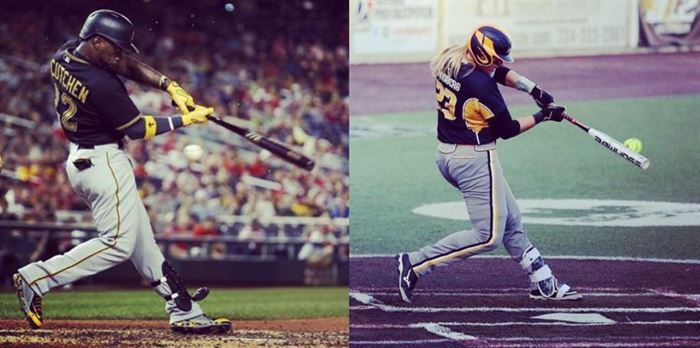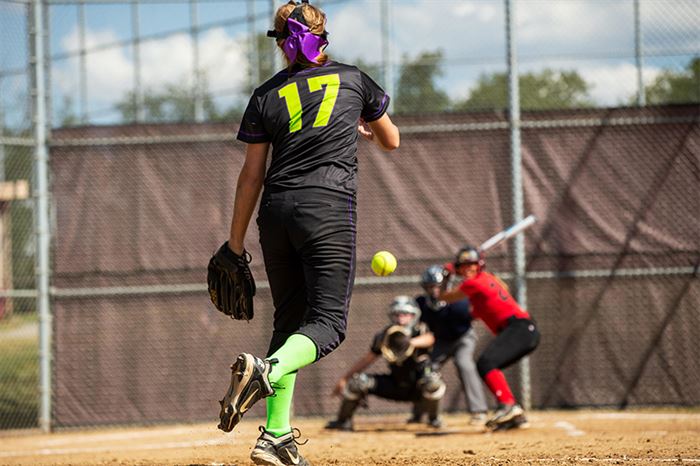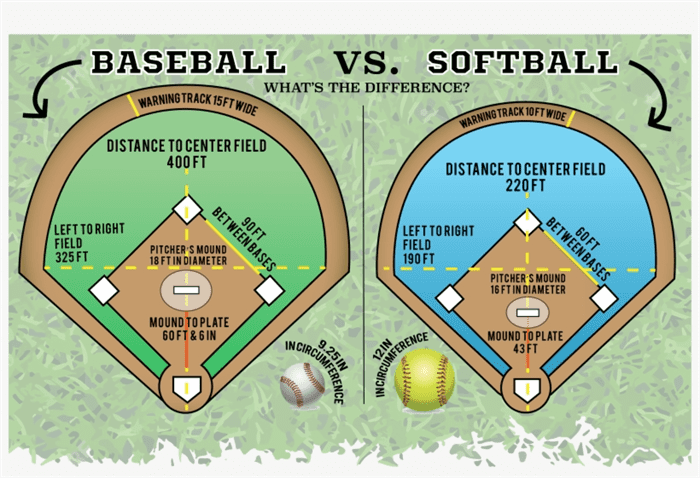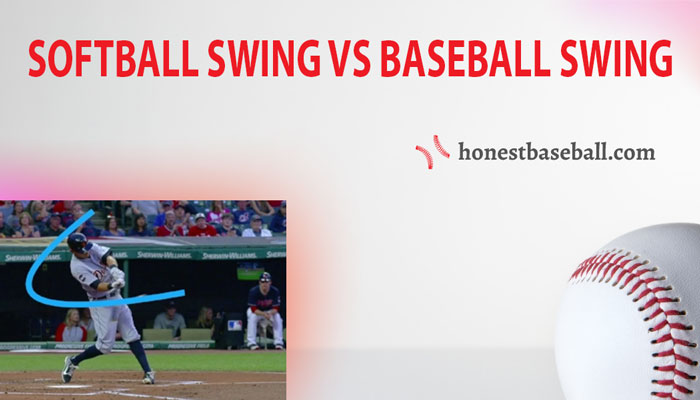Softball swing vs Baseball swing – is there any difference? As I am working as a high school baseball coach, I often hear this question. Honestly, they are almost the same in my opinion. If your swing is good, then it is good.
Many of you have heard from other coaches that baseball swing and softball swing have their differences. If you understand the physics of both swings, then you will also say the swings are not so different.
So, to make a clear concept for you, I have made this guide about softball swing vs. baseball swing to make you understand their differences and similarities.
Swing Path Comparison Between Baseball vs. Softball
One day, when I was training some of my students, one of them asked me, ”Coach, one of my friends said that the swing path of baseball is different from softball.” I was a bit surprised at the beginning.
Later on, I explained to her the theory of the swing path properly. So, I have given the explanation below to her.
The swing path of softball and baseball work in similar ways. It is divided into several categories-
Attack Angle
From the zone where the bat comes from to making contact with the pitched ball is known as attack angle.
Depending on how well you can match angles with the pitched ball, you can hit properly. If you can match the pitch and stay longer on the plane, then you can hit the ball harder (exit velocity).

Now, if you compare the baseball and softball swings, you will see there are only a few differences.
In baseball, the pitches enter the hitting zone at the angle of -5 degrees and -20 degrees angle. So, to hit the ball harder, you need to angle the bat between +5 to +20.
In softball, the pitches enter the hitting zone from -4 to -16 degrees. So, to hit the softball harder, you need to hit the ball from +4 to +16 degrees.
Launch Angle
When we hit a bit, and it leaves at an angle, that angle is known as the launch angle. The higher the exit velocity, the further you can send the ball and earn successful points.
If you can match the launch angle and hit with high exit velocity, then that is a home run, surely.
Now, if you compare the launch angle between softball swing vs baseball swing, you will not see that much of a difference between them.

Have you seen any player who has a peak exit velocity under 100mph and makes a home run? No, right? That is why if their launch angle is not between 15 to 20 degrees, then it becomes a miss-hit.
The balls land in between outfielders and infielders.
If the player swings at over 105mph, then I always suggest working at higher angles. The angles can be 30 to 35 degrees.
Now, in softball, if the player has a peak exit velocity of around 80mph, then they can work their launch angle on 30 to 35 degrees. If it is lower than that, then I suggest they work their launch angle between 15 to 20 degrees.
That was the explanation I have given to my students. Many coaches still disbelieve and say that the swing path of softball swing vs. baseball swing has a difference. Then I will say to read this theory, and they will change their thoughts, too.
Do you know which bats are illegal in baseball? and why a legal baseball or softball bat can become illegal? Check out my article on Illegal baseball and softball bats.
Riseball And Swing Plane
This is the most debated theory that every coach gives when it comes to the comparison between softball swing vs baseball swing.
It is true that in softball, the rise ball can go up because of an underhand throw, and in baseball, the ball goes down.
Now, this is the part where I think people misunderstand the concept of riseball. If you throw an underhand in softball, it will not always rise. Here, the concept of gravity comes.
The same goes for baseball pitches, too. It can be hard to see the changes, but the camera has gotten the proof.

In baseball swing, even though we are throwing the ball downhill if it is thrown less than 90mph, it can drop. If it is from 60ft away from the pitch, it can go down from 6 ft to 4ft.
The same goes for softball, too! In the beginning, the ball goes up. Then, because of the lack of velocity, gravity, and air drag slows the ball down to where gravity takes over and starts pulling the ball down. The angle you will see will be around 4 to 9 degrees.
Eventually, you will find baseball swing, or softball swing can be almost the same anyway.
Speed Comparison Between Baseball Swing vs. Softball Swing
I have heard many students complaining not to play softball because of the speed of swinging. I was really surprised that day when one of my students said to me that he would not play softball because it was too boring.
It was too irresponsible for him to say that because we should respect every sport. Also, I have proved him wrong about softball swings, too.
In one of the softball matches, I batted in front of him and showed him how fast you can swing. He was really surprised and realized his mistake after that.
Whether it is a baseball swing or a softball swing, the speed is almost the same. It depends on the players how they should utilize the speed.
I have researched a lot about the speed comparison between baseball swing and softball swing, and here is all I have got for you-
- For grade school students, I have seen their average speed in both baseball swing and softball swing around 45mph to 65mph.
- For college students, as they are a bit more mature because of playing from high school, their speed increases to 80-100mph in baseball. And softball hitters have an average speed of 70-90mph.
As you can see, the difference is so minimal that you can not even identify whether they are baseball players or softball players.
Here is a link that has given the proof of softball swing speed compared to bat weight-
Reaction Time Comparison Between Baseball VS Softball
The big question I get a lot is, “What is the comparison between softball swing vs baseball swing?” Honestly, it doesn’t really matter. Without some exceptions, baseball swing and softball swing reaction times are almost the same.
The coaches who said to their players that softball swings have less reaction time than baseball swings have only done worse for the players. They created barriers and restrictions for the players to swing freely.
There can be two types of speed pitch swings: slow pitch, and fast pitch.
Are you playing softball? The comparison of Lousiville LXT vs Xeno might help you because they are the two best fastpitch softball bats in the business.
It can take only some milliseconds to reach a baseball from pitcher to the home plate. The distance from the pitcher to the home plate is approximately 55 feet. If it is a fast pitch, at 75mph, then the reaction time of the hitter can be around .45 seconds.
On the other hand, at 75mph, the average fastball reaction time in softball can be around 0.41 seconds. As you can see, the reaction time is not that different from baseball swinging reaction time.
So, for people who want to know about fastpitch softball swing vs. baseball swing, I will say they are almost the same.
You can see the same similarities between slowpitch softball swing vs. baseball swing.
If you listen to a softball coach and a baseball coach differently about slow pitch swings, then you will get almost the same answer!
Field Dimensions and Game Strategy
Understanding the Field Dimensions
Softball and baseball field dimensions significantly impact how you approach your swing.
In softball, the bases are only 60 feet apart compared to 90 feet in baseball. That means as a softball player, you have less time to react and must have a quicker swing.
In contrast, as a baseball player, you get more time to gauge the trajectory of the incoming pitch, allowing you to put more power behind your swing.
Adapting Your Swing to the Game Strategy
The game strategy in softball and baseball also influences your swing. In softball, the ball is often pitched underhand and comes in at an upward trajectory.
This requires you to have a level or slightly upward swing to make solid contact. Conversely, in baseball, pitches are typically overhand and have a downward trajectory.
Therefore, you will need to have a slight downward swing to meet the ball effectively. Remember, the right swing strategy can significantly improve your performance in either game.
Timing and Pitch Recognition in Softball and Baseball
Both softball and baseball require acute timing and pitch recognition skills. These skills are pivotal in determining the success of your swing.
In baseball, pitchers stand 60 feet 6 inches away from home plate and deliver the ball in an overhand motion. This means you have more time to recognize the pitch, whether it’s a fastball, curveball, slider, or something else.
For example, if the pitch is a fastball, you’ll notice the pitcher’s arm speed quickening and the ball spinning backward with tight, fast rotation.
Recognizing these signs allows you to time your swing correctly, enabling you to make solid contact with the ball.
In softball, however, the pitcher’s mound is much closer—just 43 feet away. What’s more, the ball is delivered underhand, which makes the ball rise as it approaches you.
This means you have less time to identify the pitch and decide whether to swing. To be successful, you’ll need to start your swing a bit earlier than you would in baseball.
For instance, if the pitcher throws a riseball, you’ll need to swing slightly underneath the incoming ball to make contact. Recognizing the pitch’s specific characteristics quickly will allow you to adjust your swing in time and hit the ball effectively.
So, whether you’re at the plate in a baseball or a softball game, remember to keep your eyes on the ball and pay close attention to the pitcher’s motions.
The more pitches you see and the more you practice your timing, the better you’ll get at recognizing pitches and choosing the right moment to swing.
Some Frequently Asked Questions
1. Should You Swing Down On a softball than a baseball?
It will be a straight no! It can naturally happen that when you are playing softball, and if you miss a hit, your coach will yell at you. They will suggest you dip your shoulder and lower your bat more. Well, from my experience, I will say it is not true.
The ball will go up if you lower your bat. That part is true. But if you look closer to the steep path, you will see that you are hitting the lower part of the ball. What if you lower your bat and hit the upper part of the ball?
This happened to many students I have seen at an early age. The ball got smothered to the ground. So, such a steep angle can restrict your batting a lot. Also, even if you hit that ball correctly, the ball will fly so weakly that it will go to the shallow right or left field.
So, I believe in flat hitters. There is a barrel path that you will see in baseball games when pro hitters swing their bats. And I think the same can be done for softball hitters, too.

Do not take in my words only. If you look for college softball hitters or pro hitters, they always go for the barrel path. If you try it yourself, I can assure you that you will not fail.
2. Is It Harder To Hit A Baseball Than A Softball?
I will say softball is harder to hit than baseball. Because if you compare both game fields, you will see that the difference between a baseball pitch and the batting zone is quite longer than a softball field.

As the softball field has less distance from the mound to the plate, it can be quite harder to control the reaction time. That is why you will find many baseball players doing some quirky moves before hitting a baseball.
3. Why Do Softball Players Run While Swinging And Baseball Players Do Not?
A softball player has to run while swinging to create the shortest distance to first base. It is like this: the shorter your swing is, the more you have opportunities to play the ball.
You will not see this a lot in baseball because there is a lot of time spent hitting and running here. But it is not a bad thing to do. If it goes with your style, then you can surely use it!
Do softball and baseball players use different types of bats?
Yes, there are differences in bat specifications for softball and baseball. Softball bats have specific size and weight regulations, usually with larger barrel diameters, while baseball bats have their own regulations regarding diameter, length, and weight distribution.
Are the grip and stance techniques different for softball and baseball swings?
Yes, there are variations in grip and stance techniques between softball and baseball swings. Softball hitters often employ a slightly different grip and stance to optimize their swing mechanics and generate power based on the nature of the game.
Final Words
I will say only one thing. That is, whether you play softball or baseball, it does not matter. Swinging comparison is only an excuse. If you are a good player, then you already know how the swinging of both sports works.
So, I will say, instead of focusing on the comparison between softball swing and baseball swing, why don’t you try it by yourself physically?

Hello everyone. My name is Jason Butler, and I live in California, America. I was a professional AAA Minor League Baseball player. I lost my chance of playing MLB for injury issues, but I did not lose my love for baseball. I attended the coaching training program and am now working as a coach in a small school in San Diego.
I always love to share my experience and knowledge if that can help you. Play baseball, and stay fit.
